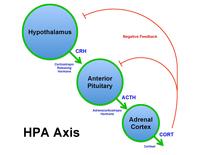
Photo from wikipedia
Deficits of visuospatial orienting in brain-damaged patients affected by hemispatial neglect have been extensively investigated. Nonetheless, spontaneous spatial orienting in naturalistic conditions is still poorly understood. Here, we investigated the… Click to show full abstract
Deficits of visuospatial orienting in brain-damaged patients affected by hemispatial neglect have been extensively investigated. Nonetheless, spontaneous spatial orienting in naturalistic conditions is still poorly understood. Here, we investigated the role played by top-down and stimulus-driven signals in overt spatial orienting of neglect patients during free-viewing of short videos portraying everyday life situations. In Experiment 1, we assessed orienting when meaningful visual events competed on the left and right side of space, and tested whether sensory salience on the two sides biased orienting. In Experiment 2, we examined whether the spatial alignment of visual and auditory signals modulates orienting. The results of Experiment 1 showed that in neglect patients severe deficits in contralesional orienting were restricted to viewing conditions with bilateral visual events competing for attentional capture. In contrast, orienting towards the contralesional side was largely spared when the videos contained a single event on the left side. In neglect patients the processing of stimulus-driven salience was relatively spared and helped orienting towards the left side when multiple events were present. Experiment 2 showed that sounds spatially aligned with visual events on the left side improved orienting towards the otherwise neglected hemispace. Anatomical scans indicated that neglect patients suffered grey and white matter damages primarily in the ventral frontoparietal cortex. This suggests that the improvement of contralesional orienting associated with visual salience and audiovisual spatial alignment may be due to processing in the relatively intact dorsal frontoparietal areas. Our data show that in naturalistic environments, the presence of multiple meaningful events is a major determinant of spatial orienting deficits in neglect patients, whereas the salience of visual signals and the spatial alignment between auditory and visual signals can counteract spatial orienting deficits. These results open new perspectives to develop novel rehabilitation strategies based on the use of naturalistic stimuli.
Journal Title: Cortex
Year Published: 2019
Link to full text (if available)
Share on Social Media: Sign Up to like & get
recommendations!